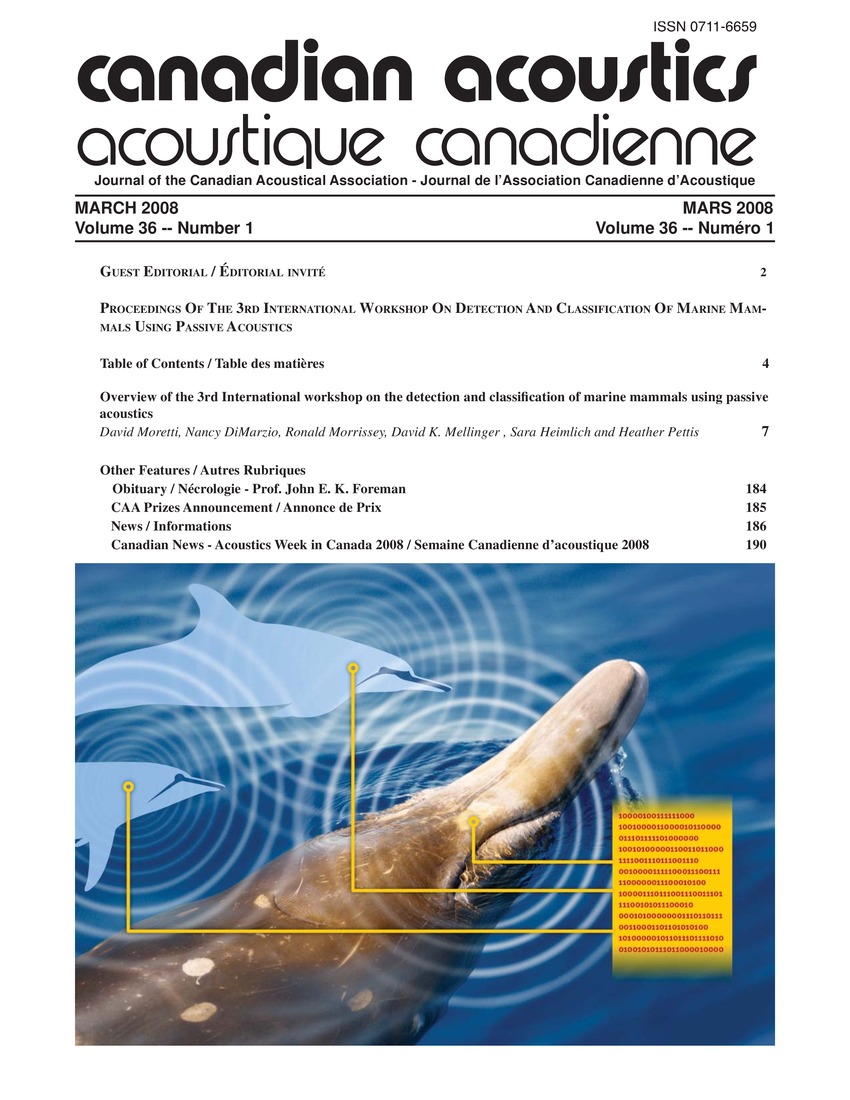Statistical classification of odontocete clicks
Keywords:
Acoustics, Bubbles (in fluids), Classifiers, Electroacoustic transducers, Hydrophones, Learning systems, Mammals, Parameter estimation, Ships, Sonar, Statistical methods, Ultrasonic applications, Underwater audition, Odontocetes, Passive acoustics, Sperm whalesAbstract
To the best of our knowledge, all odontocetes produce some kind of click like vocalisation, which is used primarily for echolocation but may also play a role in social communication. Characteristics of these echolocation pulses range from the broad band but relatively low frequency clicks of sperm whales to the ultrasonic, narrow-band clicks of harbour porpoise. Although these clicks are often easily detected, it can be difficult to classify them to species, thereby hampering efforts to monitor and study odontocetes using passive acoustics. Candidate clicks from three species were detected using a simple energy trigger, operating in the frequency band of interest. The clicks were then identified to species using two different statistical classifiers to separate beaked whale vocalisations from those of other odontocete sounds. In the first, a number of parameters (peak frequency, mean frequency, sweep frequency, click duration, width of principal spectral peak and the relative energy in different frequency bands) were calculated and a tree classifier was used to separate clicks of different species. In the second, the spectral energy in 32 relatively coarse energy bands 1.5 kHz wide were used as input to a multivariate classifier. Both classifiers were trained and tested using data provided to the 3rd International Workshop on Detection and Classification of Marine Mammals using Passive Acoustics in order to assess the classifiers performance with Blainville's beaked whales, short-finned pilot whales and Risso's dolphin clicks. The methods were also applied to survey data collected using a towed hydrophone deployed from a sailing research vessel in the Bahamas. Some of the towed hydrophone data were collected over the US Navy's AUTEC range where independent confirmation of beaked whale vocal activity was available from bottom-mounted hydrophones.Additional Files
Published
How to Cite
Issue
Section
License
Author Licensing Addendum
This Licensing Addendum ("Addendum") is entered into between the undersigned Author(s) and Canadian Acoustics journal published by the Canadian Acoustical Association (hereinafter referred to as the "Publisher"). The Author(s) and the Publisher agree as follows:
-
Retained Rights: The Author(s) retain(s) the following rights:
- The right to reproduce, distribute, and publicly display the Work on the Author's personal website or the website of the Author's institution.
- The right to use the Work in the Author's teaching activities and presentations.
- The right to include the Work in a compilation for the Author's personal use, not for sale.
-
Grant of License: The Author(s) grant(s) to the Publisher a worldwide exclusive license to publish, reproduce, distribute, and display the Work in Canadian Acoustics and any other formats and media deemed appropriate by the Publisher.
-
Attribution: The Publisher agrees to include proper attribution to the Author(s) in all publications and reproductions of the Work.
-
No Conflict: This Addendum is intended to be in harmony with, and not in conflict with, the terms and conditions of the original agreement entered into between the Author(s) and the Publisher.
-
Copyright Clause: Copyright on articles is held by the Author(s). The corresponding Author has the right to grant on behalf of all Authors and does grant on behalf of all Authors, a worldwide exclusive license to the Publisher and its licensees in perpetuity, in all forms, formats, and media (whether known now or created in the future), including but not limited to the rights to publish, reproduce, distribute, display, store, translate, create adaptations, reprints, include within collections, and create summaries, extracts, and/or abstracts of the Contribution.


